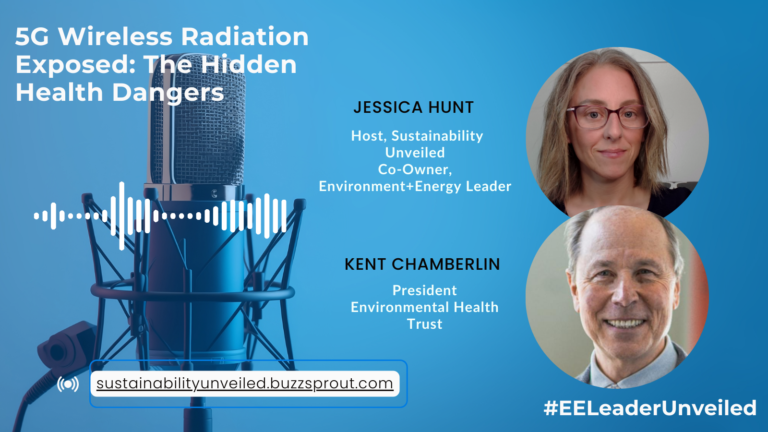In today’s fast-changing, technology-driven society, it’s important to recognize that not all innovations come without a cost. One such advancement, wireless radiation, specifically the widespread adoption of 5G technology, carries significant health risks that are often ignored or overlooked.
The Federal Communications Commission (FCC), the agency responsible for setting exposure limits to wireless radiation, bases its regulations on aging studies from the 1980s. Critics argue that these studies, which involved small numbers of animals, fail to accurately predict potential harms to humans. This discrepancy highlights the urgent need for new, comprehensive research to ensure safety standards can keep up with technological advances.
Recently, E+E Leader’s Jessica Hunt sat down with Kent Chamberlin, president of the Environmental Health Trust, to discuss the health effects of 5G wireless radiation.
A Brief History of Cell Phone Towers in the United States
Since the 1990s, the number of cell towers around the world has grown exponentially. In the United States, the number of cell towers grew from approximately 900 in 1985 to more than 308,334 in 2016. As of 2021, industry reports suggest the number of cell towers exceeds 500,000, driven by the proliferation of 5G base stations and private residential access points. The Telecommunications Act of 1996 and subsequent legislation facilitated the rapid deployment of these towers, limiting local government and resident input and often ignoring health and environmental impacts.
Telecommunications companies frequently rent rooftops of schools, churches, businesses, and apartment buildings for cell towers, resulting in dense clusters of antennas that continuously radiate microwave radio frequencies. In densely populated urban areas, cell towers are often located every 1-3 miles. With the introduction of 5G, the range of high-frequency signals has decreased, so cell towers are now required every 750 feet. Recent generations have added multiple frequency bands (low, mid, and high), further exacerbating the health effects.
Incomplete Exposure Guidelines and Growing Evidence of Harm
The International Commission on Non-Ionizing Radiation Protection (ICNIRP) guidelines limiting exposure to electromagnetic fields are designed to protect humans from radio frequency electromagnetic fields (RF) between 100 kHz and 300 GHz. These guidelines apply to a range of technologies and applications, including 5G, WiFi, Bluetooth, cellular and base stations.
The human exposure guidelines established by the self-proclaimed ICNIRP focus on short-term tissue heating, not biological effects such as DNA damage, cancer, or neurological disorders. 5G deployment continues based on these flawed standards, despite a US lawsuit documenting the FCC’s failure to update its guidelines to take harmful effects into account. Scientific evidence is increasingly clear that radio frequency radiation from cell phone base stations harms humans and wildlife. Some countries, such as Russia, China, and Switzerland, have set stricter precautionary standards than ICNIRP.
Scientific concerns and health effects
Exposure to wireless radiation has been scientifically linked to DNA damage and causes oxidative stress, free radicals and chronic inflammation. Acute reactions to such exposure exacerbate these invisible threats. Documented symptoms include headaches, fatigue, insomnia, memory loss, confusion, nausea and weakness.
Scientists and medical experts are increasingly concerned about potential long-term health risks associated with 5G technology, with the International Agency for Research on Cancer (IARC) classifying radio frequency electromagnetic fields as possibly carcinogenic to humans, highlighting the need for more research into the correlation between wireless radiation and cancer.
2022 review by biologist Alfonso Balmori Environmental Studies He highlights the significant health risks from cell phone base station radiation. In his review of 38 studies from around the world, 73.6% of the studies found adverse effects such as radiofrequency sickness, cancer and biochemical changes. These findings are significant considering that similar harmful effects have been found in studies of animals and trees near cell phone base stations that are not affected by psychosomatic factors.
Mitigation Strategies for Businesses, Schools, and Consumers
As these concerns grow, consumers are encouraged to take proactive steps to minimize their exposure to wireless radiation. Effective strategies include:
- Using a Wired Connection: If possible, choose a wired internet connection instead of Wi-Fi.
- Strategic Router Placement: To reduce your exposure, place your router in a less-trafficked area of your home or workplace.
- Turn off Wi-Fi: Disable the Wi-Fi function on your device when not in use.
- Measuring exposure levels: Use a meter to measure your exposure levels and ensure they stay within safe limits.
Raising public awareness and support
There is a growing demand from consumers and industry stakeholders for transparency about the health effects of wireless radiation. Grassroots efforts such as opposition to the siting of cell phone towers near schools reflect growing public awareness and concern about the issue.
Balancing innovation with health considerations, with sustainability in mind, is essential for a brighter, more sustainable future. This approach promotes personal wellness, benefits our professional environments, and paves the way for healthier technological advancements.
The hidden health hazards of wireless radiation require serious attention, especially with the advent of 5G technology. As we continue to integrate advanced technologies into our daily lives, we must prioritize comprehensive research and take precautions to protect public health. Emphasizing sustainability and transparency in technological development will lead to a healthier, more informed society.
5G Wireless Radiation Exposure: Hidden Health Hazards
The conversation will explore concrete steps individuals can take to mitigate risks and challenges to industry standards and will emphasize the importance of informed decision-making to protect public health as communications technology rapidly evolves.
For more information or to receive copies of the slides Kent mentioned in the conversation, please email us. [email protected].


